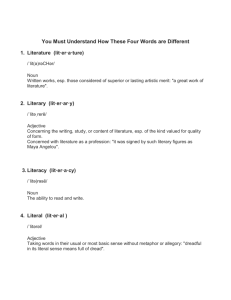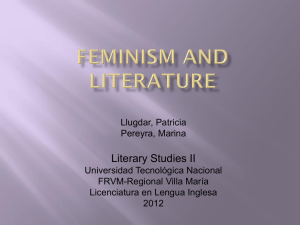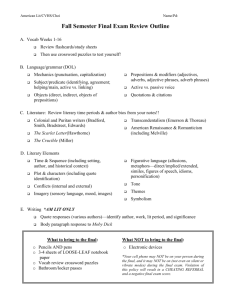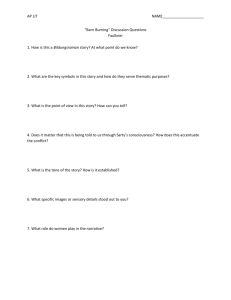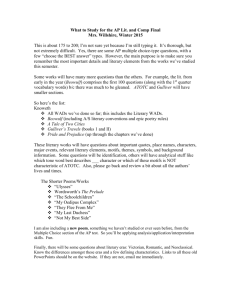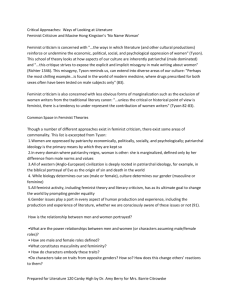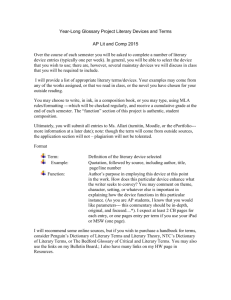Critical Lenses: Feminist, Historical, Reader Response
advertisement
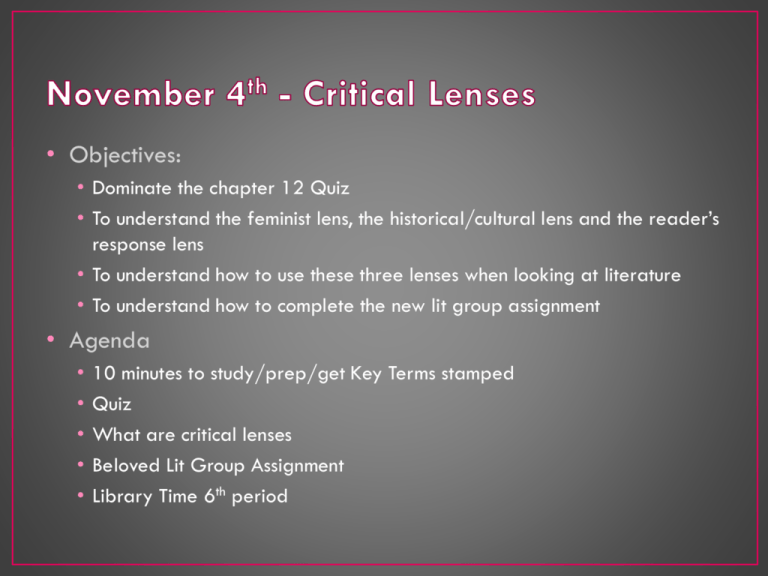
• Objectives: • Dominate the chapter 12 Quiz • To understand the feminist lens, the historical/cultural lens and the reader’s response lens • To understand how to use these three lenses when looking at literature • To understand how to complete the new lit group assignment • Agenda • • • • • 10 minutes to study/prep/get Key Terms stamped Quiz What are critical lenses Beloved Lit Group Assignment Library Time 6th period • Feminist criticism is concerned with "...the ways in which literature (and other cultural productions) reinforce or undermine the economic, political, social, and psychological oppression of women" (Tyson). This school of theory looks at how aspects of our culture are inherently patriarchal (male dominated) and "...this critique strives to expose the explicit and implicit misogyny in male writing about women" (Richter 1346). This misogyny, Tyson reminds us, can extend into diverse areas of our culture: "Perhaps the most chilling example...is found in the world of modern medicine, where drugs prescribed for both sexes often have been tested on male subjects only" (83). • Feminist criticism is also concerned with less obvious forms of marginalization such as the exclusion of women writers from the traditional literary canon: "...unless the critical or historical point of view is feminist, there is a tendency to under-represent the contribution of women writers" (Tyson 82-83). • There are 3 waves of feminist critic. We will focus on the 3rd. • Third Wave Feminism - early 1990s-present: resisting the perceived essentialist (over generalized, over simplified) ideologies and a white, heterosexual, middle class focus of second wave feminism, third wave feminism borrows from post-structural and contemporary gender and race theories (see below) to expand on marginalized populations' experiences. Writers like Alice Walker work to "...reconcile it [feminism] with the concerns of the black community...[and] the survival and wholeness of her people, men and women both, and for the promotion of dialog and community as well as for the valorization of women and of all the varieties of work women perform" (Tyson 97). • Typical questions: • How is the relationship between men and women portrayed? • What are the power relationships between men and women (or characters assuming male/female roles)? • How are male and female roles defined? • What constitutes masculinity and femininity? • How do characters embody these traits? • Do characters take on traits from opposite genders? How so? How does this change others’ reactions to them? • What does the work reveal about the operations (economically, politically, socially, or psychologically) of patriarchy? • What does the work imply about the possibilities of sisterhood as a mode of resisting patriarchy? • What does the work say about women's creativity? • What does the history of the work's reception by the public and by the critics tell us about the operation of patriarchy? • What role the work play in terms of women's literary history and literary tradition? (Tyson) • This school, influenced by structuralist and post-structuralist theories, seeks to reconnect a work with the time period in which it was produced and identify it with the cultural and political movements of the time (Michel Foucault's concept of épistème). New Historicism assumes that every work is a product of the historic moment that created it. • A helpful way of considering New Historical theory, Tyson explains, is to think about the retelling of history itself: "...questions asked by traditional historians and by new historicists are quite different...traditional historians ask, 'What happened?' and 'What does the event tell us about history?' In contrast, new historicists ask, 'How has the event been interpreted?' and 'What do the interpretations tell us about the interpreters?'" (278). So New Historicism resists the notion that "...history is a series of events that have a linear, causal relationship: event A caused event B; event B caused event C; and so on" (Tyson 278). • New historicists do not believe that we can look at history objectively, but rather that we interpret events as products of our time and culture and that "...we don't have clear access to any but the most basic facts of history...our understanding of what such facts mean...is...strictly a matter of interpretation, not fact" (279). Moreover, New Historicism holds that we are hopelessly subjective interpreters of what we observe. • Typical questions: • What language/characters/events present in the work reflect the current events of the author’s day? • Are there words in the text that have changed their meaning from the time of the writing? • How are such events interpreted and presented? • How are events' interpretation and presentation a product of the culture of the author? • Does the work's presentation support or condemn the event? • Can it be seen to do both? • How does this portrayal criticize the leading political figures or movements of the day? • How does the literary text function as part of a continuum with other historical/cultural texts from the same period...? • How can we use a literary work to "map" the interplay of both traditional and subversive discourses circulating in the culture in which that work emerged and/or the cultures in which the work has been interpreted? • How does the work consider traditionally marginalized populations? • At its most basic level, reader response criticism considers readers' reactions to literature as vital to interpreting the meaning of the text. • Tyson explains that "...reader-response theorists share two beliefs: 1) that the role of the reader cannot be omitted from our understanding of literature and 2) that readers do not passively consume the meaning presented to them by an objective literary text; rather they actively make the meaning they find in literature" (154). • Typical questions: • How does the interaction of text and reader create meaning? • What does a phrase-by-phrase analysis of a short literary text, or a key portion of a longer text, tell us about the reading experience prestructured by (built into) that text? • Do the sounds/shapes of the words as they appear on the page or how they are spoken by the reader enhance or change the meaning of the word/work? • How might we interpret a literary text to show that the reader's response is, or is analogous to, the topic of the story? • What does the body of criticism published about a literary text suggest about the critics who interpreted that text and/or about the reading experience produced by that text? (Tyson 191) • Download the assignment from the website and follow along as I go over the instructions • Important dates: • • • • • • • • Tuesday November 8: Beloved 1-5 (Lit Group 1) Monday November 14: Beloved 6-9 (Lit Group 2) Friday November 18: Beloved 10-12 (Lit Group 3) Tuesday November 22: Beloved 13-15 (Lit Group 4) Tuesday November 29: Beloved 16-19 (Lit Group 5) Thursday December 1: Beloved 20-24 (Lit Group 6) Tuesday December 6: Beloved 25-26 (Lit Group 7) Thursday December 8: Beloved 27-end (Lit Group 8)

